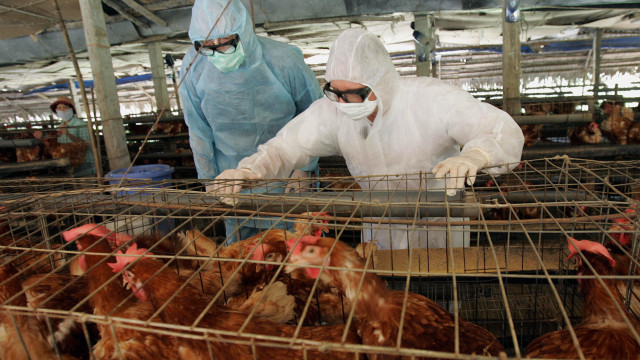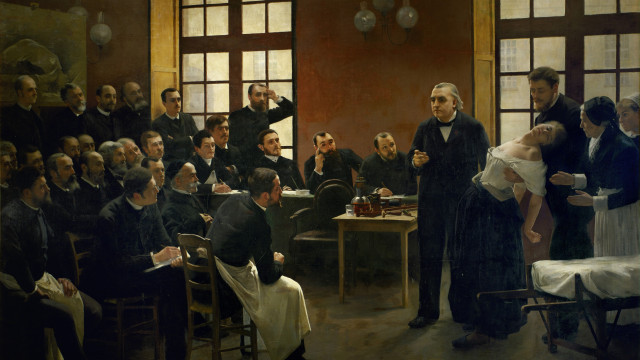






























See Also
See Again
© Getty Images
0 / 31 Fotos
The spread of H5 bird flu
- As H5 bird flu continues to spread among wild birds, poultry, and livestock worldwide, there have been several documented cases of the virus in humans.
© Getty Images
1 / 31 Fotos
Evolving knowledge
- While the current risk to public health is low, experts are nonetheless working to understand more about the virus and how it spreads.
© Getty Images
2 / 31 Fotos
What causes bird flu
- H5 bird flu is caused by the highly pathogenic H5N1 virus. It is usually transmitted by wild birds that shed the virus in their poop.
© Getty Images
3 / 31 Fotos
The possibility of airborne spread
- When there was an H5 outbreak at a maximum security chicken farm in the Czech Republic, however, experts began to wonder about the possibility of airborne spread.
© Getty Images
4 / 31 Fotos
Lack of data
- The idea that the wind can spread bird flu is nothing new. However, until recently, there was no reliable data on the topic, since it is very difficult to measure.
© Getty Images
5 / 31 Fotos
Early investigations
- When scientists started to investigate the outbreak at the Czech chicken farm, their only lead was a nearby duck farm, where an outbreak had occurred a week earlier.
© Getty Images
6 / 31 Fotos
Nearby duck farm
- The duck farm, which was home to 50,000 birds, was very different from the chicken farm in terms of biosecurity.
© Getty Images
7 / 31 Fotos
Top facilities
- At the chicken farm, the facilities were state of the art. Think filtered water, giant fans to create one-way airflow, and a secure fence to keep wild animals out.
© Getty Images
8 / 31 Fotos
Lower level facilities
- At the duck farm, by contrast, the birds were kept in buildings with natural ventilation and a minimum level of biosecurity.
© Getty Images
9 / 31 Fotos
Difference in trajectory
- The bird flu swept through the duck farm much quicker than it did the chicken farm. Indeed, 800 birds died on the first day alone.
© Getty Images
10 / 31 Fotos
End result
- However, the infection did eventually spread throughout the entire chicken farm, which consisted of two distinct locations.
© Getty Images
11 / 31 Fotos
Pulling samples
- In order to see what they could learn, investigators took samples of the bird flu found at each of the three locations (the duck farm and the two chicken farm locations).
© Getty Images
12 / 31 Fotos
Findings
- Three H5N1 strains sequenced from the duck farm were genetically identical to the strains found in the first bird to get sick on each farm.
© Getty Images
13 / 31 Fotos
Interpreting the results
- According to the researchers, this serves as evidence that the duck farm had been the source of the outbreak at the chicken farm.
© Getty Images
14 / 31 Fotos
Explaining the spread - Upon learning this, investigators wracked their brains for a physical link between the duck farm and the chicken farm that would explain the spread of disease between the two.
© Getty Images
15 / 31 Fotos
No physical link
- However, the duck farm was nearly five miles west of the chicken farm, and there was no human connection (such as an employee or a supplier).
© Getty Images
16 / 31 Fotos
Looking at weather patterns
- After ruling out all other potential reasons for the spread of the virus, investigators began to look at the weather patterns during the week the chickens got sick.
© Getty Images
17 / 31 Fotos
Perfect conditions
- They found that conditions were, in fact, perfect for the spread of the virus from the ducks to the chickens.
© Getty Images
18 / 31 Fotos
Cool temperatures and cloud cover
- There had been a steady breeze from the west and sufficient cloud cover to block germ-killing UV rays from the sun. The temperature was also cool, but not freezing, which is optimum for a virus.
© Getty Images
19 / 31 Fotos
Best explanation
- According to the author of the study, the investigators decided that the best explanation for the outbreak at the chicken farm was an airborne spread of the virus from the duck farm.
© Getty Images
20 / 31 Fotos
Going forward
- In light of this evidence, experts have called for farmers to consider the airborne spread of bird flu when thinking about how to protect their birds and livestock.
© Getty Images
21 / 31 Fotos
Current measures
- This is not to suggest that current precautions, such as restricting entry to farms and requiring personnel to wear protective equipment, are not important.
© Getty Images
22 / 31 Fotos
Layered approach - However, it seems likely that a layered approach to protection will be the best course of action going forward.
© Getty Images
23 / 31 Fotos
Extra protection
- For example, farmers may consider filtering the air in their barns, as well as continuing with other measures, in order to provide another layer of protection for their animals.
© Getty Images
24 / 31 Fotos
Transmission in humans
- In terms of bird flu cases in humans, experts believe that airborne spread of the virus may be involved in cases where there is no other identifiable source of transmission.
© Getty Images
25 / 31 Fotos
Explaining unusual cases
- For example, three veterinarians tested positive for H5N1 antibodies at a recent conference, and only one of them had known exposure to a sick animal.
© Getty Images
26 / 31 Fotos
General rule - However, it is important to note that the current iterations of the H5N1 virus do not seem to be very effective at infecting humans in general.
© Getty Images
27 / 31 Fotos
Current risk
- Of course, that may change as time goes on and the virus mutates. For now, however, the risk to the human population is low.
© Getty Images
28 / 31 Fotos
Another distinction
- Furthermore, it would probably take a lot more of the virus to infect a human than it takes to make a bird sick.
© Getty Images
29 / 31 Fotos
Low levels of the virus in the air
- Viruses disperse in the air, meaning that they would only be present in the wind in tiny amounts. Therefore, it would seem there is minimal cause for concern. Sources: (CDC) (CNN) See also: Why have flu deaths in kids hit a new record in the US?
© Getty Images
30 / 31 Fotos
© Getty Images
0 / 31 Fotos
The spread of H5 bird flu
- As H5 bird flu continues to spread among wild birds, poultry, and livestock worldwide, there have been several documented cases of the virus in humans.
© Getty Images
1 / 31 Fotos
Evolving knowledge
- While the current risk to public health is low, experts are nonetheless working to understand more about the virus and how it spreads.
© Getty Images
2 / 31 Fotos
What causes bird flu
- H5 bird flu is caused by the highly pathogenic H5N1 virus. It is usually transmitted by wild birds that shed the virus in their poop.
© Getty Images
3 / 31 Fotos
The possibility of airborne spread
- When there was an H5 outbreak at a maximum security chicken farm in the Czech Republic, however, experts began to wonder about the possibility of airborne spread.
© Getty Images
4 / 31 Fotos
Lack of data
- The idea that the wind can spread bird flu is nothing new. However, until recently, there was no reliable data on the topic, since it is very difficult to measure.
© Getty Images
5 / 31 Fotos
Early investigations
- When scientists started to investigate the outbreak at the Czech chicken farm, their only lead was a nearby duck farm, where an outbreak had occurred a week earlier.
© Getty Images
6 / 31 Fotos
Nearby duck farm
- The duck farm, which was home to 50,000 birds, was very different from the chicken farm in terms of biosecurity.
© Getty Images
7 / 31 Fotos
Top facilities
- At the chicken farm, the facilities were state of the art. Think filtered water, giant fans to create one-way airflow, and a secure fence to keep wild animals out.
© Getty Images
8 / 31 Fotos
Lower level facilities
- At the duck farm, by contrast, the birds were kept in buildings with natural ventilation and a minimum level of biosecurity.
© Getty Images
9 / 31 Fotos
Difference in trajectory
- The bird flu swept through the duck farm much quicker than it did the chicken farm. Indeed, 800 birds died on the first day alone.
© Getty Images
10 / 31 Fotos
End result
- However, the infection did eventually spread throughout the entire chicken farm, which consisted of two distinct locations.
© Getty Images
11 / 31 Fotos
Pulling samples
- In order to see what they could learn, investigators took samples of the bird flu found at each of the three locations (the duck farm and the two chicken farm locations).
© Getty Images
12 / 31 Fotos
Findings
- Three H5N1 strains sequenced from the duck farm were genetically identical to the strains found in the first bird to get sick on each farm.
© Getty Images
13 / 31 Fotos
Interpreting the results
- According to the researchers, this serves as evidence that the duck farm had been the source of the outbreak at the chicken farm.
© Getty Images
14 / 31 Fotos
Explaining the spread - Upon learning this, investigators wracked their brains for a physical link between the duck farm and the chicken farm that would explain the spread of disease between the two.
© Getty Images
15 / 31 Fotos
No physical link
- However, the duck farm was nearly five miles west of the chicken farm, and there was no human connection (such as an employee or a supplier).
© Getty Images
16 / 31 Fotos
Looking at weather patterns
- After ruling out all other potential reasons for the spread of the virus, investigators began to look at the weather patterns during the week the chickens got sick.
© Getty Images
17 / 31 Fotos
Perfect conditions
- They found that conditions were, in fact, perfect for the spread of the virus from the ducks to the chickens.
© Getty Images
18 / 31 Fotos
Cool temperatures and cloud cover
- There had been a steady breeze from the west and sufficient cloud cover to block germ-killing UV rays from the sun. The temperature was also cool, but not freezing, which is optimum for a virus.
© Getty Images
19 / 31 Fotos
Best explanation
- According to the author of the study, the investigators decided that the best explanation for the outbreak at the chicken farm was an airborne spread of the virus from the duck farm.
© Getty Images
20 / 31 Fotos
Going forward
- In light of this evidence, experts have called for farmers to consider the airborne spread of bird flu when thinking about how to protect their birds and livestock.
© Getty Images
21 / 31 Fotos
Current measures
- This is not to suggest that current precautions, such as restricting entry to farms and requiring personnel to wear protective equipment, are not important.
© Getty Images
22 / 31 Fotos
Layered approach - However, it seems likely that a layered approach to protection will be the best course of action going forward.
© Getty Images
23 / 31 Fotos
Extra protection
- For example, farmers may consider filtering the air in their barns, as well as continuing with other measures, in order to provide another layer of protection for their animals.
© Getty Images
24 / 31 Fotos
Transmission in humans
- In terms of bird flu cases in humans, experts believe that airborne spread of the virus may be involved in cases where there is no other identifiable source of transmission.
© Getty Images
25 / 31 Fotos
Explaining unusual cases
- For example, three veterinarians tested positive for H5N1 antibodies at a recent conference, and only one of them had known exposure to a sick animal.
© Getty Images
26 / 31 Fotos
General rule - However, it is important to note that the current iterations of the H5N1 virus do not seem to be very effective at infecting humans in general.
© Getty Images
27 / 31 Fotos
Current risk
- Of course, that may change as time goes on and the virus mutates. For now, however, the risk to the human population is low.
© Getty Images
28 / 31 Fotos
Another distinction
- Furthermore, it would probably take a lot more of the virus to infect a human than it takes to make a bird sick.
© Getty Images
29 / 31 Fotos
Low levels of the virus in the air
- Viruses disperse in the air, meaning that they would only be present in the wind in tiny amounts. Therefore, it would seem there is minimal cause for concern. Sources: (CDC) (CNN) See also: Why have flu deaths in kids hit a new record in the US?
© Getty Images
30 / 31 Fotos
The role of wind in the spread of bird flu
Can the virus be spread by the air?
© Getty Images
With global cases of H5 bird flu on the rise, people are becoming increasingly concerned about how the disease is spread. We know for sure that humans can become infected through contact with a sick animal. But could it also be possible to contract the virus from the air?
Check out this gallery to find out more.
RECOMMENDED FOR YOU






























MOST READ
- Last Hour
- Last Day
- Last Week








